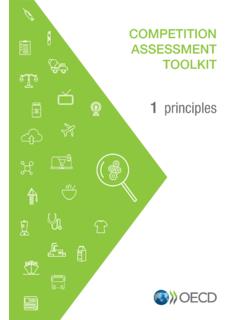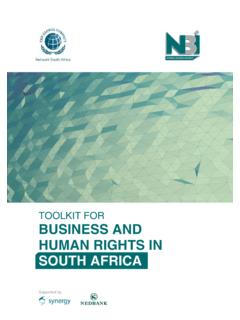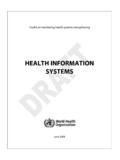Transcription of Work related stress - Topic Inspection Pack
1 Topic Inspection pack work - related stress OCTOBER 2011 work related stress : October 2011 Author: Human Factors, Ergonomics & Psychology Unit 1 work related stress Inspection pack CONTENTS 1 Introduction What is work - related stress Nature of the problem Diversity 2 stress inspections Overview Proactive Inspection Responding to complaints Enforcement guidance Checking compliance with Improvement Notices Lessons From Enforcement Action 3 Management Standards Aide Memoir 4 Background Management Standards Applying the Management Standards in an SME Links with managing sickness absence and return to work (MSA & RTW) APPENDICES 1 The Management Standards states to be achieved (STBA) 2 Management Standards Aide Memoir 3 Template Improvement Notice for risk assessment 1 4 Template Improvement Notice for risk assessment action plan 2 5 Points to consider when serving an Improvement Notice 6 Suggested paragraphs to include in a covering letter accompanying an IN 7 Reference list work related stress : October 2011 Author: Human Factors, Ergonomics & Psychology Unit 2 1 INTRODUCTION What is work - related stress ?
2 work - related stress is defined by the HSE as the adverse reaction people have to excessive pressures or other demands placed on them . This is not the only definition in common usage; there are many others in circulation. Increasingly, the term psychosocial risk factor is being used to describe those factors, which if not properly managed, can result in cases of work - related stress . The term, psychosocial risk is favoured by the European Union (EU) and is increasingly being included in new directives and guidance. In simple terms, psychosocial refers to the effects of individual psychological factors such as personality and beliefs combined with environmental social factors such as team relationships and organisational culture. In itself stress is not an illness, it is a natural human reaction, but if this reaction is prolonged over a long time period it can lead to physical and/or mental ill health. stress is normally included in a group of conditions, along with depression and anxiety, referred to as common mental health conditions.
3 Depression and anxiety are recognized medical conditions with clearly defined diagnostic criteria whereas stress is not. However, there is a large overlap between the causal factors and symptoms of these conditions which is why they are normally grouped together. Nature of the problem work - related stress , depression or anxiety has been, along with musculoskeletal disorders (MSD), the leading causes of working days lost through work - related injury or ill health over many years. The estimated incidence and prevalence rates of common mental health problems in the working population have remained fairly static over recent years. However, the days lost per case has been on a downward trend and currently stands at days lost per certified case, down from 31 days in 2004. Diversity Inspectors should be aware of who, in terms of diversity are the target group in the sector they are dealing with. It is not about treating everyone the same but about addressing individual requirements in relation to Gender, Age, Disability, Race, Religion and Belief, Sexual orientation and Transgender.
4 Inspectors should give consideration to and factor into their approach any issues that may surround their audience, such as literacy, English as a second language and disability (access needs). Public bodies are legally required to eliminate unlawful discrimination and to promote equality of opportunity when organising campaigns, work programmes and policy proposals or reviews. work related stress : October 2011 Author: Human Factors, Ergonomics & Psychology Unit 3 HSE must ensure the services we provide are accessible and meet the needs of those we serve and the Equality Impact Assessment Toolkit is a way of assessing how a policy/guidance/webpage/regulation affects individuals. An Equality Impact Assessment (EIA) looks at the actual, potential or likely impact of a service, policy, project or significant change, on different groups of people. It is also important to include gender issues in workplace risk assessments, and mainstreaming gender issues into risk prevention is now an objective of the European Community.
5 For further information, please see: http://intranet/diversity/impact work related stress : October 2011 Author: Human Factors, Ergonomics & Psychology Unit 4 2 stress INSPECTIONS Overview The focus of stress inspections is to ensure duty holders are undertaking a suitable and sufficient risk assessment for work - related stress , following the Management Standards for work - related stress (Management Standards) or an equivalent approach. Further background information on the Management Standards can be found in Section 4. HSE statistics indicate that the health, education, local government, central government and financial services sectors have the highest incidence and prevalence of work - related stress . During the period of the stress Priority Programme (2004-2009) the above sectors were defined as high priority and subject to proactive inspections. The HSE Approach HSE believes that the Management Standards approach is an efficient and flexible way to carry out a suitable and sufficient risk assessment and organisations are encouraged to take this approach.
6 Organisations can adopt the Standards either wholly or in part so long as the process produces a suitable and sufficient risk assessment. It is recognised that duty holders may be adopting alternative approaches to risk assessment. Advice and support on assessing the outcomes of equivalent risk assessment processes can be accessed via HSE s Human Factors, Ergonomics and Psychology Unit (HFEP) Unit. A suitable and sufficient risk assessment should cover the following: Hazard identification (which will entail data gathering and analysis); Gap analysis (comparison of the current state with the states to be achieved in the Management Standards (See Appendix 1), or other KPI s); Solution development; and, Action planning. Employee involvement and management commitment throughout the risk assessment process are key to ensuring that appropriate hazards are identified and practical solutions are considered.
7 Please refer to the Worker Consultation and Involvement Topic Inspection pack for general information on employee engagement. Risk control strategies for work - related stress follow the hierarchy of control approach and can be categorised as: 1) Primary interventions that include organisational strategies for reducing exposure to stressors at work and minimising the risk of work - related stress (equivalent to control at source); work related stress : October 2011 Author: Human Factors, Ergonomics & Psychology Unit 5 2) Secondary interventions, including stress management training (analogous to minimisation); and 3) Tertiary interventions such as the provision of employee assistance programmes are provided by some duty holders. Such interventions, although not enforceable are considered good practice. They can supplement primary and / or secondary interventions but it is not recommended that these exist in isolation.
8 Inspectors should emphasise the need for duty holders to focus on implementing primary interventions so far as is reasonably practicable, complemented as appropriate with secondary and tertiary interventions. Inspectors may find that duty holders do not uniformly implement a risk assessment process across the entire organisation at once. There will be circumstances where duty holders roll out the process in stages or implement in one area of the organisation, refine their process/plan, and then roll out across the rest of the organisation. This is acceptable so long there are clear plans in place to cover the whole organisation. Responding to complaints Investigation of complaints should only be considered where: There is evidence that a number of staff are experiencing work - related stress or stress - related ill health; and, There is scope for effective intervention at the organisational level. Inspectors should not investigate individual work - related stress complaints and should confine their involvement to assessing organisational arrangements for stress management.
9 Applying health and safety legislation to an individual case of work - related stress is not straight forward because it is difficult to prove a causal link between particular causes and possible workplace stressors to the necessary standard of proof ( beyond reasonable doubt ) required for health and safety legislation. Often individual complaints relate to bullying, harassment or other employment relations issues which are normally managed within the framework of wider employment legislation. This is the responsibility of the Department for Business, Innovation and Skills (BIS - formerly BERR and before that DTI) and HSE does not have the power to investigate individual employee relations cases. In these circumstances individuals should be directed to BIS or the Arbitration Conciliation and Advisory Service (Acas) who are better placed to provide advice on such matters. Contact details for BIS and Acas are provided in Appendix 7.
10 NB. work on work - related stress is not intended to deal with post incident trauma, and post-traumatic stress disorders. Enforcement guidance Enforcement action is likely to be limited. In some circumstances, however, action will need to be taken to secure compliance with Regulation 3 of the Management of work related stress : October 2011 Author: Human Factors, Ergonomics & Psychology Unit 6 Health and Safety at work Regulations 1999, requiring completion of a suitable and sufficient risk assessment. There is also evidence that the areas of work design/organisation (Demands, Control, Support, Role, Relationship and Change), included in the HSE Management Standards, can if not adequately managed, give rise to a risk of work - related stress . If an organisation has failed to respond to advice, has not undertaken a suitable and sufficient risk assessment for work - related stress and shows no evidence of having plans to do so, enforcement action should be considered where the inspector is of the opinion that employees are exposed to risks to their health and safety from exposure to stressors at work .

















